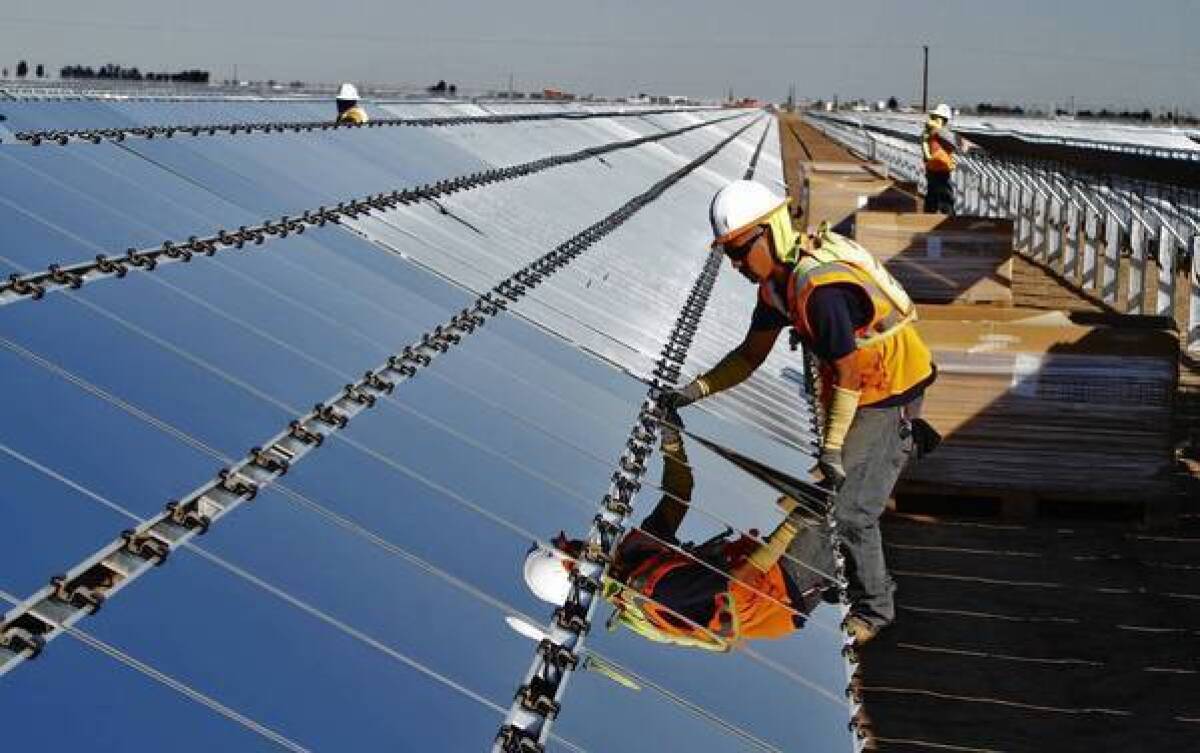Imperial County betting its future on renewable energy

Situated in the southeastern corner of California, bordering Arizona and Mexico, Imperial County has long depended on agriculture and cash crops that grew from the good earth.
But lately the region — which carries the dubious distinction of having the state’s highest unemployment rate at 25.5% — is betting its future on a different kind of farm: green energy.
Spurred by a state mandate that requires utilities to get a third of their electricity from green sources by 2020, renewable energy companies are leasing or buying thousands of acres in Imperial County to convert to energy farms providing power for coastal cities — bringing an estimated 6,000 building jobs and billions in construction activity to the county.
Although renewable energy projects are sprouting up across the Golden State, no county needs them as much as Imperial, which has consistently ranked as the worst-performing region of California even in boom times.
The prospect of a construction boom has excited residents hungry for work. But some farmers and Native American tribes are crying foul, angry that the new projects are encroaching on land that they claim has cultural value or should be devoted to crops.
Solar, wind and geothermal projects are popping up on farms that once grew wheat, alfalfa and sugar beets. County officials say the normally hardscrabble region is benefiting from vast tracts of affordable land and lots of sunshine, the one resource the region can almost always count on.
“It’s sunny 365 days of the year, damn near,” boasted Mike Kelley, chairman of the county’s Board of Supervisors. “Renewable energy is going to give Imperial County a shot in the arm.”
Local advocates are betting that a “green rush” will lift a county that has struggled with economic upheaval. The Bureau of Labor Statistics just ranked El Centro as the second-worst metro area for job hunters, after Yuma, Ariz. Its unemployment rate fluctuated between 25% and 33% from 2010 and 2012.
Two of the county’s top five employers are the Calipatria and Centinela state prisons. The agriculture sector shed jobs as farmers moved to automation and switched to less labor-intensive crops. Construction work vanished when El Centro, the county’s biggest city, was hit hard by the housing crisis. Long-standing businesses such as a food processing plant moved elsewhere, taking away hundreds of jobs.
But with green energy companies scrambling to build solar installations and wind farms throughout the county, some residents are convinced that Imperial’s fortunes will soon be looking up.
Tenaska Solar Ventures plans to break ground this year on its second project in the county after nearing completion on its first site, known as the Imperial Solar Energy Center South, on nearly 1,000 acres near El Centro.
The company came to the region both for its “abundant sunshine” and also proximity to the Sunrise Powerlink, a power transmission line completed last year that connects Imperial and San Diego counties, said Bob Ramaekers, Tenaska’s vice president of development.
More than 500 construction workers have been hired to work on Tenaska Imperial South, with 70% coming from the local community, he said. A job fair held last year drew about 1,200 applicants. The second project will generate as many as 300 construction jobs, with priority given to local hires.
“One of the advantages of solar projects is they are not really high-tech. Anyone who has worked at all in the construction business can work in a solar facility,” said Andy Horne, deputy executive officer of the county’s natural resources department. “It’s like a big erector set — you bolt these things together and ba-da-bing, you have a solar project.”
The lure of a steady, well-paid job is what persuaded Victor Santana, 27, to start training as a journeyman electrician two years ago. He had studied film in college and hoped to make movies, but ended up working a series of odd jobs after the economic downturn — driving tractors, operating hay presses, selling vacuum cleaners. Even a video-editing gig he eventually found paid minimum wage,
“Things had dried up. There was only field work, or fast food, or working at the local mall,” the El Centro resident said.
Santana finally decided to switch careers after hearing the pitch from green energy companies trickling into town. Now he earns about $21 an hour with regular raises every six months, and the prospect of steady work for another seven to 10 years just from the stream of solar and wind projects. “I feel a lot more secure than I did,” he said.
Green energy may help Imperial hold onto its young people, who often try to land a government job or leave the county altogether in search of better-paying jobs elsewhere. Calipatria Unified School District is launching a vocational program this fall to prepare high school graduates for jobs in renewable energy. San Diego State is building a power plant simulator at its Brawley campus.
“With the advent of renewable energy, we are seeing a different kind of industrial base,” said Mike Sabath, associate dean of academic affairs at San Diego State’s Imperial Valley campus. “Hopefully that will provide opportunities to develop more job stability in the region than what we have enjoyed.”
But construction has raised the hackles of some locals. There are farmers wringing their hands over fertile land snapped up by energy companies; they worry that a way of life is being edged out by corporations eager to cash in on the modern gold rush.
And environmental groups and Native Americans tribes have brought suit against multiple solar and wind projects, complaining that they despoil land that is both ecologically important and culturally significant.
The latest suit, filed in May by the Quechan tribe of the Ft. Yuma Indian Reservation, seeks to stop a wind farm on more than 10,000 acres of public land near Ocotillo in western Imperial County.
“To allow a project of such magnitude to be erected next to one of our sacred sites — which helps form our identity as Quechan — would be a desecration of our culture and way of life,” the lawsuit said.
Economists are more skeptical about the long-term benefit to the county. They point out that solar and wind farms bring in an initial boom of constriction jobs, but require very few workers once they’re up and running.
The five projects being built in Imperial County will generate 1,946 temporary construction jobs but only 71.5 permanent positions, according to a county economic impact study. The sites will generate sales tax revenue of $47 million and add some much needed money into the county’s coffers, said Horne of the natural resources department.
“It’s the nature of these kind of power plants. Once you build them, there are no moving parts and you don’t need many folks to maintain them,” said Alan Bernheimer, spokesman for First Solar Inc., which recently began building its own Imperial project that is estimated to create 250 construction jobs. “It does not provide substantial long-term employment.”
But local businesses say even a temporary surge of jobs is better than nothing.
Sierra Jaime, director of sales for two Marriott hotels in El Centro, said calls are flooding in from workers on two solar farms that recently began construction.
“You definitely see a spike, and it’s just beginning,” she said. “If we have people staying at hotels, they’ll eat at restaurants next door, they’ll shop at the mall.... We topped the charts for many years as having the highest unemployment, so this is great.”
More to Read
Inside the business of entertainment
The Wide Shot brings you news, analysis and insights on everything from streaming wars to production — and what it all means for the future.
You may occasionally receive promotional content from the Los Angeles Times.











